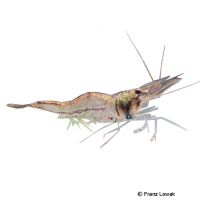Nigerian Floating Shrimp (Desmocaris trispinosa)
| Nigerian Floating Shrimp Desmocaris trispinosa | |
|---|---|
| Name | Nigerian Floating Shrimp |
| Name Lat. | Desmocaris trispinosa |
| Family | Desmocarididae |
| Family lat. | Desmocarididae |
| Order | Decapoda |
| Order lat. | Decapoda |
| Origin | West Africa |
| Habitat | Ponds, swamps |
| Diet | Algae, leaves, shrimp food |
| pH | 6.0-7.5 |
| Behavior | Peaceful |
| Keeping | Group |
| Care Level | Moderate |
| Reproduction | Oviparous |
| Breeding | Difficult |
| Life Span | 1-2 years |
| Protection | No |
| Metric Units | |
| Size | 3,5-4,5 cm |
| Temperature | 22-28 °C |
| Hardness | 6-9 °dH |
| Aquarium | 30 l |
| US Units | |
| Size | 1.4"-1.8" |
| Temperature | 72-82 °F |
| Hardness | 107-160 ppm |
| Aquarium | 10 gal |
Distribution and habitat
Nigerian hover shrimp are widely distributed in West and Central Africa. They live in swamps as well as in nutrient-rich, stagnant or gently flowing waters with muddy bottoms covered with fallen leaves.
Maintenance
They need a partly densely planted aquarium with roots and stones as well as a free swimming space. The substrate of dark sand or gravel should be partially covered with foliage (e.g. sea almond leaves, oak leaves), which provides hiding places and is also part of the diet, as well as rotting plant material and mulm
No ammonia, ammonium and nitrite should be detectable in the aquarium water, the nitrate value should not exceed 100 mg/l. To ensure the water quality and oxygen content, a filter and heater adapted to the size of the aquarium is required, as well as lighting for the species-appropriate day-night rhythm of the animals. When choosing the filter, special care should be taken to ensure that the animals cannot be sucked in.
Diet
The food supply consists of foliage, live, frozen and dry food. For a balanced diet, feed with a high quality shrimp food (granules, pellets) as well as autumn leaves (e.g. oak, beech, maple, birch), sea almond leaves, algae leaves and scalded spinach, supplemented with cyclops, daphnia, artemia or mosquito larvae (live or frozen)
It is sufficient to feed them about 3 times a week. Unaccepted food should be siphoned off after about 12 hours, leaving the foliage in the aquarium as permanent food. Regular and varied feeding promotes the well-being of the animals.
Behaviour and compatibility
They should be kept in a group of at least 10 animals. It is recommended to keep them in a species tank. However, they can also be kept with small peaceful fish, snails and other dwarf shrimp in a community tank.
Basically, only compatible animals with similar demands on water conditions and water temperature should be socialized.
Reproduction and breeding
The larger females can be identified by their downturned belly pouches and neck patch (egg pre-production), or by the large eggs on their webbed feet.
From 10-15 very large eggs hatch after 5 to 6 weeks fully developed juveniles, which immediately begin to search for food. The sensitive juveniles require especially clean water. The use of a UV sterilization system is recommended.
Important
They are buoyant and appear to float through the water. By bending their swimming legs (plepods) sideways, they can swim forward and backward.
Gapless aquarium cover is necessary as they can also climb and jump
Foliage (sea almond tree, oak, beech, etc.) not only provides cover, but as it rots it encourages the development of microorganisms that provide a valuable secondary food source.
The well-being of the animals should be monitored regularly. Temperature should be checked daily, pH, hardness and nitrate levels at least every 14 days. Regular partial water changes are recommended, even when contaminant levels have not yet reached the upper limit. Sudden changes in water quality should be avoided. Newly introduced animals must be accustomed slowly to the water in the aquarium.
Further literature can be found in your pet store.
References
Text: petdata; Image: Franz Lowak
Source: KARGE & KLOTZ (2008): Süßwassergarnelen aus aller Welt, Dähne Verlag; ENGELMANN & LANGE (2011): Zootierhaltung - Tiere in menschlicher Obhut: Wirbellose, Verlag Harri Deutsch
